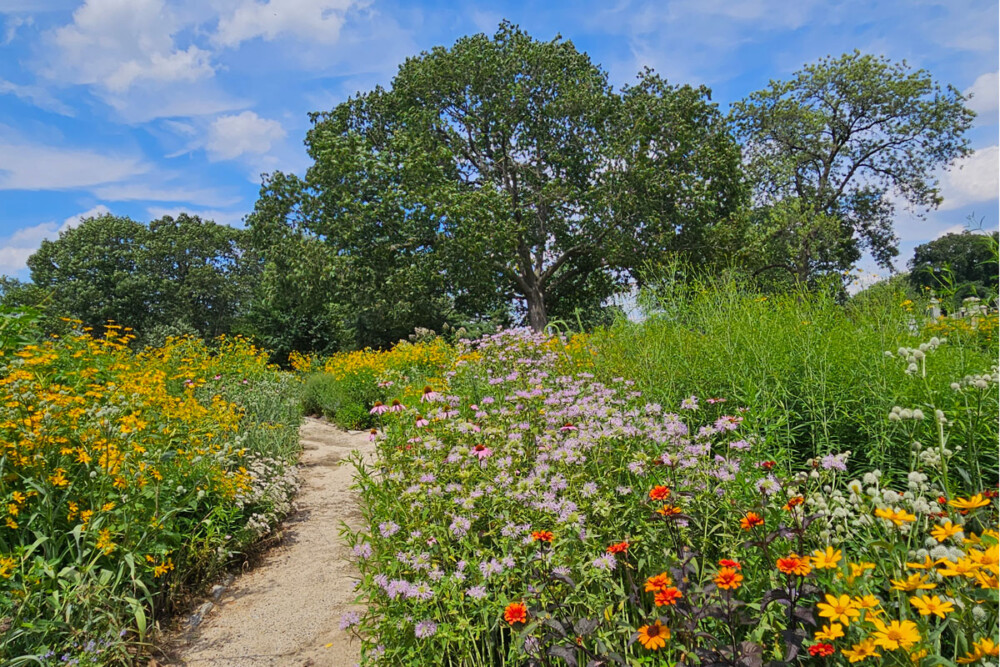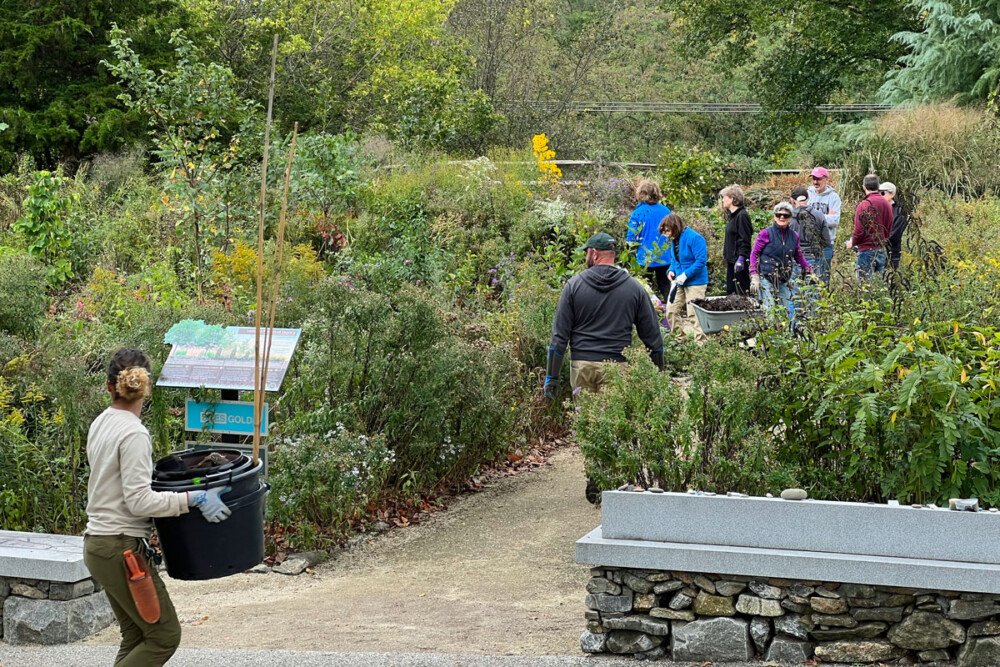
Choosing a Green burial: Life after Life in Nature’s Sanctuary
How succession forests and wildflowers form a living memorial for loved ones at Laurel Hill
The path to Nature’s Sanctuary is long, a series of turns and loops winding through the many compact neighborhoods that comprise West Laurel Hill Cemetery’s 187 acres, slowly leading toward the northern outskirts of the grounds, where it overlooks the Cynwyd Heritage Trail. The journey lends a sense of significance to this serene corner of the cemetery, where a successional forest is patiently rising up from the earth – and those buried within it.
Beneath the young paw paw, redbud and beech trees, the 478 graves that spread across the site’s two-thirds of an acre are slowly being filled in by people who have chosen a green burial. Interred in shrouds or biodegradable vessels and free of any synthetic chemicals, they will eventually be returned fully to the beautiful nature that surrounds them. On a brisk January afternoon, the sanctuary is in a wintry state of hibernation, but in spring and summer wildflowers burst forth, painting the landscape in amber, peach, lavender and sage.
“People who come here to visit are really struck by the peace and tranquility they find visiting their loved ones in this kind of environment,” arboretum manager Aaron Greenberg says.
This land was once the place where Laurel Hill deposited the dirt it dug out for the cemetery’s 93,000 traditional graves, but in 2008 it was turned into a destination for green burials, offering a space for those interested in a more natural ending to their journey. After a renovation of the sanctuary in the middle of last decade, it received SITES Gold status for its sustainability, an equivalent to LEED certification that had never before been bestowed on a cemetery.
The Growing Demand for Green Burials
All sites in Nature’s Sanctuary are dug by hand, no gas-powered equipment is allowed, and only organic sprays like horticultural vinegar are used. Those buried here will decompose fully over time. The site began with 322 graves but added space for 156 more in 2022; only 46 remain unclaimed, according to Nancy Goldenberg, Laurel Hill’s president and CEO.
About 10% of Laurel Hill’s sales are now for green burials, Goldenberg says, as more people turn away from traditional procedures like embalming, which allows toxic chemicals to leak into the soil and groundwater. Even cremation, long considered an austere alternative to burial in a mausoleum or at the foot of a gravestone, sends carbon dioxide spewing into the air. Going green also avoids many of the funeral costs that often tally several thousand dollars.
“Interest has spiked in the past couple years, there’s no question about that,” Goldenberg says. “People are becoming more environmentally conscious.”
The cemetery has two other plots set aside exclusively for green burials: Valley View Green, at Laurel Hill East, a quarter-acre with space for 391 graves, covered in tall grasses and shrubs; and Bala Green, a half-acre with a capacity of 376 not far from Nature’s Sanctuary, which opened in December and just held its first burial.
Nature’s Sanctuary will eventually grow into a native forest as its plantings move through the successional process. Greenberg and arboretum staff plant aggressively after a burial to promote the growth of native plants, utilizing leaf mulch and other materials recycled from the wider cemetery and stormwater collected from a nearby rain garden. Over time, the sanctuary is transitioning from a field of wildflowers and grasses into a landscape of shrubs and saplings that will someday stand proudly above those buried here. Among green burial sites, which vary widely in their disposition, Nature’s Sanctuary stands out in its approach, Greenberg says.
“The fact that we built and are stewarding intentional, ecologically minded landscapes sets the bar a little higher,” he says. “The hope is to be a model for what green burial can be.”
As available land for interring our dead becomes scarcer, green burial, which allows the dead to be placed in closer proximity, offers an answer, Goldenberg says. Nature’s sanctuary is intersected by footpaths that allow visitors to walk through and appreciate the scenery on the way to and from a loved one’s burial site. Rather than using headstones, the names of those buried in the sanctuary are engraved atop a stone half-wall that borders the sanctuary.
A Legacy of Environmental Stewardship

Each fall, Laurel Hill invites the families of those interred in Nature’s Sanctuary to gather together to help tend to the site. It’s a way to connect not just with the land, but with others who have experienced grief. The cemetery also launched last year a four-session therapeutic horticulture program that expands the same opportunity to the wider public. It will be back again in 2024.
“It might not necessarily be for everybody, but for those who do choose to come, there’s something very therapeutic and beautiful about digging into the earth,” Goldenberg says of the family work day.
The presence of Nature’s Sanctuary and Laurel Hill’s other green burial plots has put the idea into the minds of those who might not have previously considered it. Greenberg, whose family is Jewish, had always assumed his parents would be buried in one of the local Jewish cemeteries where their family has plots. But since he began working at Laurel Hill, they learned more about green burial. Now, he says, they’ve purchased plots in Nature’s Sanctuary.
Greenberg leads tours of Laurel Hill’s trees throughout the year, as well as private tours for garden clubs. They always stop by Nature’s Sanctuary, which has become a horticultural highlight for the cemetery, all while offering people a greener way to leave the earth behind.
“It’s become a destination, something really unique to us,” Greenberg says. “There’s no place quite like it anywhere else.”
Photos: Laurel Hill









